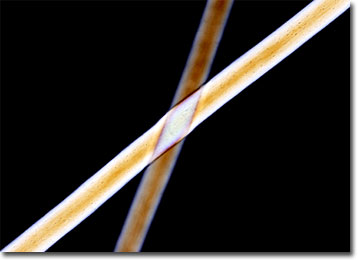Polarized Light Microscopy Digital Image Gallery
Angora Goat Hair
The Angora goat is a breed that originated in the Angora province of Asia Minor in ancient times. Prized for its long, lustrous coat, the animal was protected from exportation from the region until the sixteenth century and was not introduced to the United States until the mid-1800s.

Typically smaller than other types of goats and sheep, the Angora goat is often said to have a gentle disposition. It breeds in autumn and has a gestation period of approximately 149 days. Through selective breeding, the ruminantís outer coat of coarse guard hairs has been almost completely eliminated, leaving behind only a soft, fleecy underfur that grows in long locks. These locks are usually sheared twice annually, producing about 10 pounds of fleece per year per animal.
Despite the name, Angora fabrics sold in stores do not come from the fleece of the Angora goat. Rather, items so marked are created from the fur of the Angora rabbit. Commercially, the hair of the Angora goat, as well as the fabrics made from it, is known as mohair, a term that derives from the Arabic word mukhayyar. Mohair, which is revered for its beauty as well as its strength and durability, was at one time so valuable that it was solely utilized in the wardrobe of the Sultan of Turkey. In modern times, however, mohair finds use in many items, but primarily outerwear, sweaters, and upholstery fabrics.
